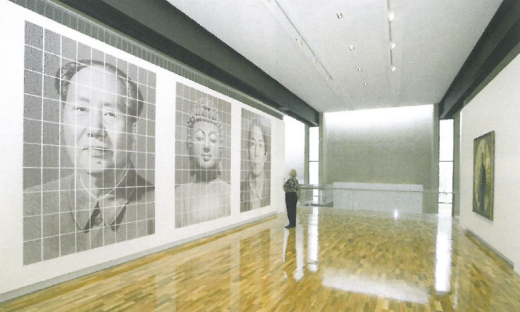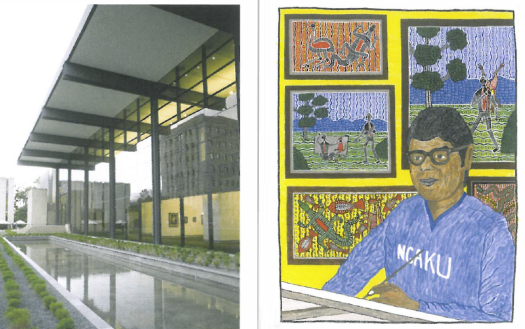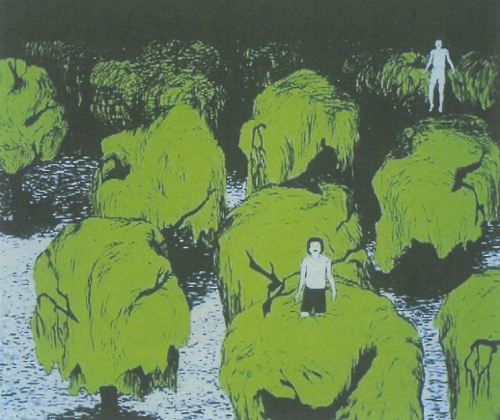
The architectural concept for the Mayne Centre started with some fortuituous circumstances, said the architect, Hamilton Wilson. UQ had outgrown the old Mayne Hall and proposed that the building be converted to house the University Art Museum (UAM). The architects had the large footprint of old Mayne Hall and its south-facing glass wall to turn to their advantage. Wilson explained that normally it wouldn't be acceptable for an art museum to feature a full glass wall directly facing gallery space, because of the risks of light and heat on artworks. But, as it already existed, the opportunity to use natural light for the exhibition spaces became a central part of the concept, with air circulation and set-backs designed around it. An internal pod was inserted into the building to accommodate two levels of art gallery space.
The glass wall reflects the passing parade of university life, from the austere stone façade of the law building opposite to the animated groups of students walking by. The new structure heralds a new purpose, which the Vice Chancellor, Professor John Hay, describes as a state-of-the-art home for the University Art Museum and a wonderful new cultural facility. UAM houses Queensland's second largest public art collection. Its Director, Ross Searle, foresees that future acquisitions will continue to represent major trends in Australian art alongside an exhibition program that is cutting-edge, exploratory and issue based.
Collections map the interests of individuals and groups associated with it, and UQ's art collection is no exception. It commenced in the 1940s with funds from the Darnell Bequest, initially managed by prominent academics who were knowledgeable amateurs and Queensland-based artists, with the vision of developing a significant collection. Dr J.V. Duhig, Professor Cummings and Professor H.C. Richards joined forces with recognised artists and other advisors, including Daryl Lindsay, Lloyd Rees, Lucy Swanton, Lillian Pedersen, Sydney Long, Roland Wakelin, Max Ragless and Vida Lahey, to build up the Darnell Collection to more than 400 works of art. From 1976, Professor Nancy Underhill provided professional input, consolidating the core collection, while it continued to evolve with focused acquisitions supported by bequests, gifts and loans. Following a collection policy review in 1997, Searle has shaped a strong commitment to Australian Indigenous art, focusing on contemporary urban Aboriginal art and Torres Strait Islander art. He is also fostering UAM's interest in contemporary Pacific art.

The opening exhibition, To Look Within: Self Portraits in Australia, fills both floors of gallery space with a stunning selection of over 100 artists' self-portraits spanning colonial times to the present. Self-portraits are the most intimate of paintings. For once the interrogatory eye of the artist has been turned upon themselves, before turning their penetrating gaze back on us.
To Look Within was co-curated by Ross Searle and Andrew Sayers, Director of the National Portrait Gallery of Australia, and contains some paintings from UAM's collection as well as works loaned from national and state art galleries. UAM's current holdings and future acquisitions of contemporary self representations by Australian artists will complement the National Portrait Gallery's more historical collection. Interestingly, the proposal for an exhibition of artists' self portraits originated from UQ's chief donor for the UAM reconstruction project, Mr Chuck Feeny of The Atlantic Philanthropies, whose foundation had assisted the acquisition of a similar collection at Limerick University in Ireland.
Presented in the Lower Gallery is the Nat Yuen Collection of Chinese antiquities, gifted to the University by scholar and connoisseur Dr Natalis Yuen, a graduate of the University of Queensland. This fine collection spans over 5,000 years of Chinese culture, acquired by Dr Yuen over 25 years. This exhibition represents one of the interconnections between UAM and teaching, learning and research at UQ. Scholars and students participate in UAM's public program of artists' talks and lectures in the Mayne Centre galleries; as well, UAM collaborates with faculties and departments hosting artists in residence and visiting scholars and developing innovative opportunities for artists on campus.
Teaching, learning and research are pivotal roles for university art museums. Associate Professor Margaret Maynard commented that there had always been strong links between Art History and UAM. The teaching of subjects such as Curatorial Practice and Theory and Art Writing will be enhanced by the new facility and expanded resources. UAM is committed to major publications and monographs, and the expanded exhibition program will give scholars further opportunities to contribute to publications.
UAM will generate a significant proportion of its exhibitions and public programs, but it is also keen to receive innovative exhibitions developed by other galleries. Here's a taste of what audiences can look forward to at UAM in its 2004-2005 program: the next artists' self portraits exhibition in the genre of photography; Queensland at War a broadly based social and cultural exhibition developed in collaboration with the Brisbane Institute. Then, coming from the Adam Gallery of the Victoria University of Wellington, NZ, Tatau - an exploration of Samoan tattooing on and off-shore. Further down the line, an exhibition in collaboration with Ian Potter Gallery questioning Un-Australian Art and the Art on Campus project led by David Pestorius, envisaging 15 artworks installed around UQ's St Lucia campus.












